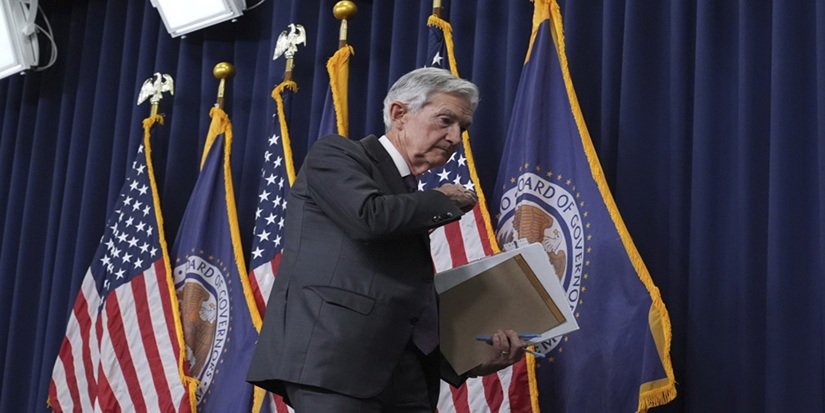
The Fed Can’t Save You This Time
-
 Patrick Watson
Patrick Watson
- |
- April 15, 2025
- |
- Comments
Say what you will about the economy, the 2020s haven’t been boring. On top of a pandemic and ensuing inflation wave, now we have a trade war, recession fears, and maybe more inflation. Not to mention capital flying out of US dollar assets.
American investors are accustomed to what was once called the “Greenspan Put.” When things got crazy, the Federal Reserve would fire its artillery and make everything good again. They did it in the dot-com crash, the housing crash, the COVID recession and, most recently, the 2023 mini bank crisis.
It’s thus easy to believe Jerome Powell will drop more liquidity bombs. But even if that happens, we have a bigger problem…
The Fed’s weapons may not work this time.

Source: Wikimedia Commons
Changing Leverage
This time last year I was saying the labor shortage makes conventional recessions almost impossible (see No More Recessions?). Now President Trump seems intent on testing my theory. I might be wrong if his tariffs do as much damage as some expect. We’ll see.
But even if we avoid recession, we could see stagflation—low growth combined with higher inflation. That scenario is particularly hard for the Federal Reserve to control. Cutting rates to stimulate growth might let inflation get out of hand, but raising rates to control inflation could hurt GDP and raise unemployment.
The bigger problem: It’s not clear either strategy would work like it used to. Let me explain.
Like what you're reading?
Get this free newsletter in your inbox regularly on Tuesdays! Read our privacy policy here.
Fed officials have several ways to influence the economy. We usually think about interest rates, but they can also nudge the banks by adjusting reserve requirements and other rules.
|
All their tools, however, relate to credit availability. They boost growth by making loans more easily available, or they reduce activity by making loans harder to get.
Normal people care about credit only to the extent they need credit. If you have enough cash on hand to do what you want, you don’t care so much about interest rates or loan terms. You just open your wallet and do it, whatever your “it” may be.
This means the Fed’s decisions disproportionately affect the most leveraged parts of the economy—those who have the most debt, or who need to borrow.
In other words, Fed policy isn’t the only variable. It also matters who is in debt. And it turns out this has changed over time.

Source: Apollo
The chart shows US debt by sector since 1990. The five lines represent debt held by the federal government, financial corporations (i.e., banks, mortgage lenders, etc.), non-financial corporations (all other businesses), households, and state & local governments. The gray bars are recessions.
Now, look at who held the most debt going into each recession.
- In 1990–91, households were the primary debtors. Hangover from the 1980s real estate boom killed many construction and manufacturing jobs. Those people got hurt, but it was a relatively mild recession that ended quickly.
- By 2001, banks had overtaken households. The Fed started tightening in mid-1999, trying to achieve a “soft landing” for the 1990s tech boom. That effort failed, leading to a worse recession than the last one. But again, it didn’t last long.
- Higher bank and household debt made the 2008 recession much worse. That excess debt got liquidated in what we now call the Great Recession.
Notice where federal debt (the orange line) was during those three recessions. It was generally flat the whole time, running 40% to 50% of GDP. But it turned upward in 2008 and kept rising.
At the same time, household and bank debt began diminishing as a share of the economy. This was partly due to post-crisis regulatory changes that made banks hold more capital.
In 2014, federal debt exceeded all the other categories. It was still growing when the 2020 COVID pandemic arrived. It leaped even higher as Congress passed giant relief bills. The federal government’s share then stabilized, more or less, while the other sectors kept slowly deleveraging.
Like what you're reading?
Get this free newsletter in your inbox regularly on Tuesdays! Read our privacy policy here.
What does this tell us?
Debt-wise, today’s economy is structurally unlike that of 1990, 2001, or 2008. The federal government, not households or businesses, is by far the biggest borrower.
Now think about what this does to Fed policy. Their tools are aimed at the segments whose debt share is already shrinking. This means…
- If recession strikes and the Fed cuts rates, the stimulus effect on the private sector will be smaller than in previous recessions.
- And if the Fed tries to fight inflation, higher rates won’t suppress private sector demand like they used to. Businesses and consumers aren’t as indebted as they were then. (Incidentally, this may explain why the economy kept humming along while the Fed was raising rates in 2022–2023.)
Higher rates will, however, increase the government’s already gigantic interest expense.
How all this will shake out, I don’t know… but I suspect history may not be the best guide to what happens next.
|
See you at the top,

Patrick Watson
@PatrickW
P.S. If you like my letters, you’ll love reading Over My Shoulder with serious economic analysis from my global network, at a surprisingly affordable price. Click here to learn more.

 Patrick Watson
Patrick Watson
